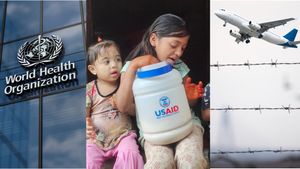Originally published by The 19th. Written by Liza Gross, Inside Climate News
More than 900 chemicals in widespread use could be increasing breast cancer risk, scientists reported in a peer-reviewed study published Wednesday.
Breast cancer is the leading cause of cancer death among women globally, and recently replaced lung cancer as the most commonly diagnosed form of the disease. Up to 80 percent of female breast cancers depend on estrogen and progesterone, and a growing body of research links increased activity of these hormones to breast cancer.
“We have evidence from both human studies and animal models supporting the idea that chemicals that increase estrogen and progesterone are health concerns and increase breast cancer risk,” said Jennifer Kay, an expert on the adverse effects of environmental exposures who led the study for the Silent Spring Institute, a nonprofit research group dedicated to reducing toxic threats to women’s health.
A traditional hallmark of cancer is uncontrolled cell proliferation, an acceleration of the normal cell division process. Most established carcinogens trigger tumor growth by harming DNA directly or by disrupting processes that regulate DNA repair or cell division. But hormones play such an important role in breast cancer, often by causing cells to proliferate, that scientists design treatments to inhibit estrogen and classify tumors based on whether they respond to hormones.
Kay and her colleagues, experts in toxicology, cancer and public health, built on a groundbreaking list of more than 200 chemicals they’d previously identified as likely to cause breast cancer in women based on their ability to produce mammary tumors in rodents. Rats and mice are the go-to species in biomedical studies partly because they share most of the genes and biological processes that cause breast cancer. But animal studies are time-consuming and expensive. Scientists are trying to reduce the number of animals they sacrifice in the lab, both for ethical reasons and to find more efficient ways to spot likely hazards.
In this study, published in Environmental Health Perspectives, the team drew on leading international and U.S. government databases and reports to identify chemicals that cause mammary tumors in rodents. They classified the chemicals based on well-established “key characteristics” that cause rodent mammary tumors, including the ability to induce cell proliferation, damage DNA, alter cell signaling and promote inflammation. They also searched studies in cell cultures to find chemicals that boost estrogen or progesterone levels, activate the estrogen receptor or damage DNA, thus increasing breast cancer risk.
They wanted to know if they could use chemicals that alter hormone activity in cell studies to reliably predict which chemicals cause tumors in the animal studies. “And we found that, indeed, chemicals that are estrogenic or increase progesterone were more likely to induce mammary tumors compared to chemicals that did not,” Kay said.
Their analysis identified 921 exposures with the potential to cause breast cancer. In addition to flagging X-rays and other forms of ionizing radiation that mutate DNA, they identified 278 chemicals that cause tumors in animal studies. They also found 642 additional chemicals that are likely to increase breast cancer risk by disrupting hormones, either by increasing production of progesterone and estradiol, estrogen, or by activating the estrogen receptor, which triggers cell growth.
“Many of these chemicals should not be considered safer alternatives or low hazard without additional investigation of their ability to impact the breast,” the authors note in the paper.
The analysis is “a huge undertaking,” said Brenda Eskenazi, an epidemiologist at the University of California, Berkeley, who was not involved in the effort. What’s novel about the study, she said, “is identifying a whole lot of chemicals that are out there, that could be a cause of breast cancer in humans.”
This study advances the science with a new strategy that considers multiple ways chemicals can exert harmful effects to expand on their original list, said Rena Jones, an environmental cancer expert at the National Cancer Institute, who was not involved in the research but co-wrote a commentary accompanying the paper.
The number of chemicals in U.S. commerce “is enormous,” Jones said, yet few have been studied in women. Most evidence of cancer-causing agents in people comes from occupational studies in men.
Yet health officials are seeing upticks of early-onset breast cancer in women that aren’t explained by things like screening and early detection, said Jones, noting that the list will help researchers focus their efforts on specific chemicals.
Scientists have long worried that chemicals like DDT and dioxins, which can interfere with hormones and were phased out years ago, can increase breast cancer risk. So including hormone-disrupting compounds as potential carcinogens, Jones said, “was really important because we frequently encounter these in daily life through lots of sources.”
Adding insult to injury
Consumers are routinely exposed to 90 percent of the chemicals pegged as potential breast carcinogens, the researchers reported.
Some of the most widely studied chemicals include classes of plastic additives called bisphenols and phthalates, parabens and PFAS — per-and polyfluoroalkyl substances — known as “forever chemicals.” They’re found in a dizzying array of products, including cash register receipts and canned food linings (bisphenols), soap, shampoo, hair spray, lubricating oils and vinyl flooring (phthalates), cosmetics, moisturizers and shaving creams (parabens) and fast-food packing, nonstick cookware, stain-resistant fabrics and mountaineering gear (PFAS).
The team hopes regulators and manufacturers use their list to prioritize chemicals for risk assessment, while recognizing how the timing of exposure may increase breast cancer risk. Exposure to hormone-disrupting chemicals when breast cells are dividing — for example, in the womb, early in life and during puberty — is likely to be especially harmful.
One thing regulators like the Environmental Protection Agency, or EPA, could do is expand screening of chemicals that many people are exposed to, Kay said. They could also recognize that chemicals that increase hormone levels are a cancer hazard.
EPA has made significant progress in addressing risks to human health and the environment from existing chemicals in part through the updated Toxic Substances Control Act, which authorizes the agency to regulate dangerous chemicals, said EPA Press Secretary Remmington Belford. “Unfortunately, our ability to implement TSCA and provide these protections has been hindered by a significant lack of resources,” Belford said, adding that the agency’s budget stagnated under “the previous administration.”
Belford did not respond to specific questions about whether the agency would consider recognizing chemicals that boost hormone levels as breast cancer hazards.
Many of the identified chemicals can both disrupt hormonal activity and damage DNA, a critical step on the road to cancer. Chemicals that cause mammary tumors in animal studies were roughly three times as likely to alter both DNA and hormones as those that don’t, the researchers found.
“The combination of being able to increase hormones, as well as being able to damage DNA, was the biggest indicator that a chemical would be able to increase risk,” Kay said, adding that experimental evidence supports the finding.
She pointed to a study of the pancreas in mice that exposed the animals to a hormone that triggers cell proliferation along with a chemical that damages DNA. The dual exposure led to far more mutations than either disturbance caused on its own.
“It's a short leap to connect this to breast cancer,” Kay said. “Estrogen and progesterone cause breast cells to proliferate, so if you have DNA damage on top of increased hormone levels, then those cells are more likely to develop mutations and become cancerous.”
In fact, studies of bisphenol A, or BPA, and di-(2-ethylhexyl)-phthalate, or DEHP, show that the hormone-disrupting plastic additives also interact synergistically to increase the incidence of rodent mammary tumors beyond what either chemical does by itself.
“At relatively low concentrations, a chemical mixture has striking effects on normal cell function that are missed by evaluation of single components,” researchers reported in a 2108 Toxicological Sciences study of BPA, parabens and PFAS.
Chemicals are typically tested for safety in isolation, even though no one is exposed to just one chemical at a time.
“Many of the chemicals on our list are already acting as co-exposures that we cannot avoid,” Kay said, adding that women of color face disproportionate risks from pollution and personal care products, as Inside Climate News has reported.
Black women and other people of color often face more toxic exposures, Kay said. “For example, the hair products Black women tend to use have more toxic chemicals compared to the hair products white women use.”
On a typical day, a person might be exposed to parabens in shampoo and body lotion, formaldehyde in hair relaxer, PFAS in a pastry wrapper, phthalates in perfume, flame retardants in carpets or couches and pesticides in food, along with any number of other pollutants in the air. If cooking with gas, one is likely to ingest high levels of benzene, a well known carcinogen associated with oil and gas development and burning fossil fuels like natural gas.
The Centers for Disease Control and Prevention’s National Biomonitoring Program routinely measures hundreds of these environmental chemicals in the blood, urine, saliva and breast milk of thousands of volunteers. The program has found many of these chemicals, including BPA, DEHP, parabens and PFAS, in nearly every person tested.
“The measurement of an environmental chemical in a person’s blood or urine is a measure of exposure,” said a spokesperson for the American Chemistry Council, the chemical industry’s leading trade group. “It does not by itself mean that the chemical causes disease or an adverse effect.”
Scratching the surface
A person’s risk of developing cancer increases with age, as the body’s DNA-protection machinery wears out. But, in people under age 50, breast cancer in women is six times more common than any type of cancer in men, said Kay.
That suggests that some sort of environmental exposure is causing tumors to develop much earlier than expected, she said.
Those exposures are likely to come in the form of any number of the currently used 40,000-plus chemicals, which are mostly made from petroleum. The EPA estimates that about half of the estimated 86,000 known synthetic chemicals are actively used.
“One of the things that really struck me about this study was recognizing that there are tens of thousands of chemicals in current use in the United States but only about 2,200, maybe 2,300, were even tested for their ability to increase estrogen or progesterone in the assays that we looked at,” Kay said.
Even when chemicals are tested, she said, they aren’t screened for some traits expected to increase breast cancer risk, like promoting inflammation or activating progesterone. And some chemicals are allowed onto the market, including widely used pesticides like atrazine and malathion, despite evidence showing that they cause mammary tumors.
“We usually think about pesticides in terms of their neurotoxicity,” said U.C. Berkeley’s Eskenazi, a leading expert on the neurodevelopmental risks of pesticides. Some pesticides like DDT that were previously identified as a cause of breast cancer are no longer used, she said. “This study is notable in identifying currently used pesticides with that potential.”
For Kay, thinking about all the chemicals she found that could be harming women hit a nerve.
It’s mind-boggling to consider how little is known about the universe of chemicals people are exposed to, Kay said. “They've only screened so many chemicals, and only for the types of activity they have screens for. Then you think about all of the activities that they don't have screens for and all of the chemicals that haven't been tested at all.”
Even so, she added, one thing is clear: The chemicals identified in this analysis act in ways that are known to increase breast cancer risk in animals.
“Even if there hasn't been enough time to really demonstrate the link in humans,” she said, “we know enough about how these chemicals could increase risk that we can start treating them as hazards.”
Women are diagnosed with lung cancer more than men, and researchers are baffled

Video Source: Advocate Channel


















































